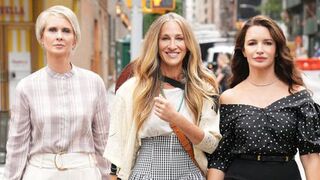Sex
And Just Like That…Middle Age Happens
Five truths about aging we can learn from the Sex and the City reboot.
Posted February 5, 2022 Reviewed by Vanessa Lancaster
Key points
- Midlife can bring significant changes like widowhood and divorce. Such challenges are more intense for people who face financial struggles.
- Women are especially vulnerable to ageism.
- Older and younger generations can support and teach each other.

Warning: Spoiler alert ahead.
One of the most talked about new TV shows this past year is And Just Like That (AJLT), the long-awaited reboot of the pathbreaking 1990s series Sex and the City (SATC).
SATC traced the friendships, romances, heartbreaks, and career paths of four 30-something best friends and the men they loved (or left). Nearly two decades later, three of those friends – writer Carrie Bradshaw, lawyer Miranda Hobbes, and art gallery manager turned full-time mom Charlotte York Goldenblatt – returned to the screen as 55-year-old women navigating new challenges.
Like millions of fans, I watched the ten episodes of AJLT as soon as they dropped.
My eager anticipation was partly personal; I grew up with these characters. We were in our early 30s in the late 1990s, enjoying the (relatively) carefree lives of single women – complete with orthopedically unsound footwear and dubious dating choices.
Now we’re in our 50s – experiencing the surprises, joys, and challenges of getting old in a world that celebrates youthful beauty. But my keen interest is also professional. I’ve studied aging for more than two decades and couldn’t help but wonder, what would AJLT get right and wrong about middle-age?
Here are five truths (and one major omission) about aging that we can learn from the series. (Spoiler alert.)
1. Married people may decide they want “more.”
Miranda dealt a crushing blow to her husband Steve when she told him she wanted a divorce after nearly 20 years of marriage. Miranda’s new relationship with non-binary comic Che Diaz triggered the breakup, but problems were long-simmering. Miranda felt bored and unfulfilled with the predictable daily life that she and Steve established, while Steve cherished the comforts of home, routine, and parenting their son Brady.
“I want more,” cried Miranda: more sex, excitement, challenge, and personal growth.
Miranda is not alone. Rates of “gray divorce,” or divorce among people ages 50 and older, more than doubled between 1990 and 2020. Women usually initiate divorce; many 50-something women realize they have decades of healthy years ahead and don’t want to spend those years with their current spouse.
If statistics are any indication, the future may bring hope for the kind and heartbroken Steve; nearly 40 percent of men marry or cohabit again after a gray divorce.
2. Ageism is inescapable, especially for women.
Ageism is rampant, and the women of AJLT are not spared. Older adults are demeaned and judged as less savvy, competent, and attractive than younger people. This mistreatment can undermine our mental health and self-esteem.
Miranda is berated for letting her hair go gray.
Carrie is made to feel stodgy and irrelevant by her younger and cooler neighbors. The most jarring instance was when Carrie accompanied her friend Anthony Marentino on his visit to a plastic surgeon.
Reeling from a breakup with his husband Stanford, Anthony wanted to look younger now that he was newly single in his 50s. The doctor quickly and blithely told Anthony, “you’re hot,” and that he didn’t need more than a Botox touch-up.
Carrie was a different story. The doctor detailed her so-called facial flaws and rattled off a list of treatments because “Mother Nature and Instagram are much harder on women.”
Art mirrors life. AJLT actor and executive producer Sarah Jessica Parker has been vocal about the ageist and misogynist attacks on her graying hair. Research confirms that women are more likely than men to be the targets of ageism, given a cultural preoccupation with youthful female beauty.
But ageism goes much deeper than insensitive jokes or comments about hair color. Older women face significant discrimination in finding work and getting promotions, undermining their long-term financial security.
3. Sex (even oral sex) is alive and well.
Charlotte and her husband Harry were about to have an intimate encounter one morning when their teenage daughter started to enter the room. A panicked Charlotte quickly slammed the door, hitting her daughter’s face.
When a guilt-ridden Charlotte told her friends, they were unconcerned about daughter Lily, yet were incredulous that Charlotte and Harry still had oral sex. “Is Harry dying? “ “Was it his birthday?” they asked.
The notion that sex (and especially oral sex) disappears with age is outdated and ageist. Sex is an important part of romantic relationships at any age; those with happy and supportive marriages enjoy the most frequent and satisfying sex. And when age-related problems like arthritis or erectile dysfunction make intercourse difficult, happily partnered older adults improvise and find new and satisfying routines.
4. Widowhood is a life-altering experience.
In the series opener, Carrie and her husband John epitomized marital bliss (despite their long and rocky courtship). Sharing meals, laughs, evening dances, and weekends in the Hamptons, Carrie finally had her “happily ever after.” Her world was shattered when John died suddenly of a heart attack.
At John’s funeral, socialite Bitsy von Muffling extended her sympathy and empathy to Carrie. Bitsy lost her husband, Bobby, to COVID-19 months earlier. The death of a spouse is devastating and much more likely to befall women than men.
Men typically die younger than women and marry women slightly younger than themselves. That’s why women in their 50s and 60s are twice as likely as men to be widowed.
Widows and widowers face profound sadness and loneliness and need to take on new tasks previously done by their late spouse – whether cooking or managing family finances.
The glimmer of hope is that depressive symptoms typically fade over time, especially for widows and widowers who have support from friends and family and find comfort in memories of their late spouse. Many even go on to find new relationships (like Carrie’s budding relationship with widowed schoolteacher Peter), recognizing that their new love is different and not a replacement for their late spouse.
However, for widowed persons who continue to suffer physically or emotionally for long periods, professional help may be necessary.
5. We can learn from younger generations, and vice-versa.
People can continue to learn, grow, and change no matter their age. The 50-something friends have been pushed to expand their world views by their children, younger colleagues, and neighbors.
Miranda learned that she was guilty of perpetuating racial microaggressions from her younger law school classmates. Charlotte and Harry developed a deeper understanding of gender fluidity when their tween child Rose re-identifies as Rock.
Carrie is pushed out of her technological comfort zone by younger colleagues who urge her to use social media. But the learning is a two-way street. The older generation’s life experience and ability to roll with the punches – a skill we hone with age – benefits the younger generation.
Carrie counsels her 20-something neighbor Lisette, hurt and humiliated by a cheating beau. Charlotte helps her daughter Lily overcome her fear of tampons. Miranda offers parenting insights to her law school professor Nya Wallace, who is ambivalent about motherhood. The series subtly conveys the futility of generational divides.
What's Missing?
There’s one important topic that the series leaves out: financial problems. The AJLT characters have opulent lifestyles – gorgeous apartments, children in private schools, and wardrobes to die for. Older women in the United States – and especially Black, Latina, and unmarried – are impoverished at rates dramatically higher than their male peers.
As I wrote about in my book Golden Years, when women take time out of work to raise families or take part-time jobs to blend work and family, these steps – compounded by a persistent gender wage gap – undermine their earnings, their future pensions, and their savings. With each passing year, the poverty gap between men and women widens. By age 75, women are 1.5 times as likely as men to be poor.
Many of the challenges of aging portrayed in AJLT are even more daunting for women (and men) with limited income and education. Health problems like Steve’s hearing loss and Carrie’s hip pains strike more intensely and at younger ages for workers in physically demanding jobs like waitresses and construction workers.
Ageism is worse for those who experience high daily stress levels, like financial worries. These strains make people “look old” at younger ages. Wrinkled skin, age spots, thin lips, gray hair, tooth problems – all inevitable parts of biological aging – appear earlier for those who can’t afford dental care, healthy diets, pricy moisturizers, and salon highlights.
That’s why social programs that provide access to health care, education, income security, and good jobs are so crucial. These investments help ensure that people (and especially women) from all walks of life can grow old with comfort and dignity.




